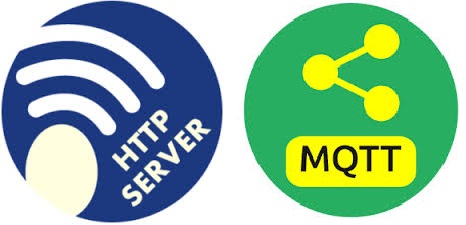The ability to communicate with your IoT things — to send commands and receive responses is an essential pillar of your “connected” system. You need a network link to control things and to read sensors. Two of the most common Internet to machine communication protocols used with the ESP8266 and other MCUs are http and MQTT.
There are advantages and drawbacks using either one of these methods.
So which one is better?
For an assessment, I created a simple Arduino IDE sketch with just two metrics in mind for the evaluation. First was the simplicity of the application code. How clean was the framework needed to implement the server?
The other concern was latency. That is, how long is required from the time of a client request to server reply? I was curious to measure this time. Is the delay magnitude in the order of milliseconds, or seconds?
The Sketch
I started out with the intent on creating two sketches; one of an http server and one for MQTT. But what became apparent was that other than the code needed to connect, read and write to the protocol, the software was almost identical. So for simplicity and efficiency, the http and MQTT servers were combined into a single sketch.
This also made the evaluation easier-there was no need to reload the firmware to switch protocols.
The typical Arduino IDE based http server requires the use of two class objects. These objects are defined in WiFi.h for Arduino based systems and the ESP8266WiFi.h library for the ESP8266.
- WiFiServer
- WiFiClient
The major shortcoming with the Arduino IDE library is the need in the user sketch to poll for new connections in the loop(). It would be far more efficient to register a callback function that is executed upon an external client connection. Like the EspressIf SDK Iot_demo example web server.
This constraint alone would be sufficient justification to use the Espressif SDK over the Arduino IDE for all but the simplest Web Server application.
Fortunately, however, there is a way to use the SDK callbacks with the Arduino IDE. Here is how it is done. That is just what we will use for comparing the http and MQTT servers. The sketch for this test is just a reuse of that sketch with the added code needed to support MQTT. The Dual MQTT & HTTP Web Server code is here.
Code Assessment
When looking at the code structure for the MQTT broker vs the Arduino Wifi library vs the SDK API, the most efficient design was the SDK API. While all 3 methods worked well, the SDK design uses a callback to service client connections without any code needed in the loop() function.
The Arduino Wifi library requires polling for connections each iteration of loop().
And sure, the MQTT broker server, like the SDK API, also uses callbacks. But it still requires the execution of “client.loop()” in the sketch’s loop() function. This consumes bandwidth which undoubtedly will add latency to other tasks added to loop().
If loop() latency becomes an issue in your sketch, use of the SDK API web server callbacks will minimize the delays.
Response Delay Evaluation
A simple web page, using only html and JavaScript was used to measure the delay from the time a request was sent to the time the reply was received. The web page file is called “mqtt_server.html”; it is on GitHub here.
The time starts when the button is clicked to send a request to the server. When the reply is received, the end time-stamp was captured. But what I found was that this end stamp was not saved immediately, resulting in inaccurate readings. This is likely due to the asynchronous nature of JavaScript. To correct this, a 1 second callback was added from the time the reply time-stamp was captured to the time the lapse time was calculated. This resulted in repeatable results which appear to accurately report the response delay.
Twelve requests were made for each of the three server setups. The average of the twelve, and the average of ten with the high and low readings removed are shown in this table:
| HTTP: WiFi Library | HTTP: SDK API | MQTT | |
|---|---|---|---|
| Sample 1 | 429 | 89 | 341 |
| Sample 2 | 457 | 32 | 362 |
| Sample 3 | 367 | 30 | 338 |
| Sample 4 | 441 | 85 | 383 |
| Sample 5 | 365 | 42 | 375 |
| Sample 6 | 400 | 28 | 417 |
| Sample 7 | 465 | 26 | 343 |
| Sample 8 | 489 | 445 | 333 |
| Sample 9 | 620 | 42 | 566 |
| Sample 10 | 358 | 32 | 339 |
| Sample 11 | 731 | 212 | 325 |
| Sample 12 | 432 | 29 | 432 |
| Average of 12 | 463 | 91 | 380 |
| Average of 10(w/o Hi & Lo) | 447 | 62 | 366 |
The time is measured in milliseconds. From this experiment, it is clear that the SDK API offers significantly less latency than either the Wifi Library or MQTT. From this, it should be clear that callbacks that do not use the sketch loop() function are more efficient.
In Closing
There are advantages and shortcomings when using either MQTT or http for web server applications. MQTT offers a clean and simple code interface, but it does require the use of a broker. That adds an additional layer of complexity and potential failure to your system.
In my opinion, MQTT is best suited to be used for data distribution, not as a web server. The MQTT publish/subscribe model works great to simultaneously send information from one source to many consumers. If speed is critical, the EspressIf SDK API is the best option to use the ESP8266 as a web server.
![]()
